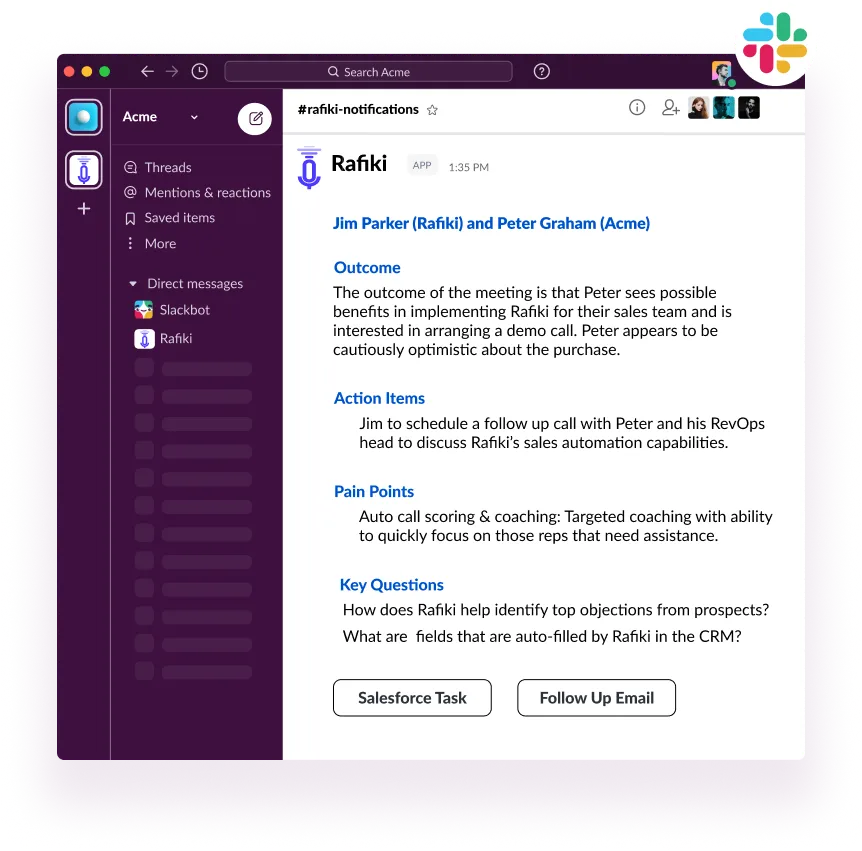Why Rafiki
Pricing


Pricing
Solutions

RevOps Leaders
Synchronize revenue generating functions

SDR Leaders
Get your team aligned and Coach your Reps 3x faster at scale

Sales Leaders
Unlock pipeline truth, drive confident forecasts

Imagine a world where every nuance of a sales call—every promise, every objection, every subtle hint of interest from a potential client—is captured flawlessly without the frantic scribbling of notes. This is no longer a realm of imagination but a reality made possible by AI-driven transcription technology. In the high-stakes arena of sales, where every interaction could make or break a deal, missing details are not just minor oversights; they can cost businesses valuable opportunities and revenue.
Gone are the days of poring over poorly recorded calls or trying to decipher hastily written summaries that miss critical information. AI-driven transcription is stepping into the spotlight, offering a transformative solution that marries accuracy with efficiency. By harnessing the power of sophisticated algorithms that understand and transcribe spoken language, this technology ensures that no detail is too small to be overlooked, and no error too subtle to be corrected.
Reflecting this shift towards innovative technologies, a recent Gartner webinar poll involving over 2,500 executives revealed a significant trend: 38% of respondents cited customer experience and retention as the primary goal of their generative AI investments, underscoring the crucial role of AI in enhancing client interactions and satisfaction.
This was followed by objectives like revenue growth and cost optimization, highlighting the diverse benefits of AI across business operations.
In this article, we'll dive into how AI-driven transcription is not just improving but revolutionizing sales call summaries. We’ll explore its impact on productivity, customer relationships, and ultimately, the bottom line. Prepare to see how integrating AI transcription into your sales strategy can open up a new frontier of possibilities.
Traditional call summarization methods have long been a critical yet cumbersome part of sales operations. Despite their importance in maintaining records and ensuring follow-ups, these manual processes come with a host of limitations that can impede the efficiency and effectiveness of a sales team.
Here, we explore some of the major drawbacks that have prompted businesses to look for more advanced solutions like AI-driven transcription.
The manual transcription of sales calls is an inherently time-intensive process. Sales representatives often spend hours documenting detailed notes from lengthy conversations, which detracts from their primary role—selling. This not only reduces the time they can spend engaging with clients but also delays the follow-up process, potentially cooling off hot leads.
Human error is a significant risk in traditional call summarization. Mishearing, omitting critical details, or simply misunderstanding the context can lead to inaccuracies in call summaries. Such errors can misguide sales strategies, lead to misinformed decisions, and even damage client relationships if promises or statements are incorrectly recorded.
Each salesperson may have a different style of note-taking and summarization, leading to inconsistent documentation across the team. This variability can create confusion and inefficiencies. It complicates matters when team members rely on each other's notes for client history and insights. Inconsistency in documentation can also make it difficult to train new team members and scale operations effectively.
As businesses grow and the volume of calls increases, the traditional methods of call summarization become increasingly unsustainable. The workload can quickly outpace a sales team's capabilities, leading to backlog and stress. This may require hiring additional staff for data entry tasks.
Traditional summaries, often being text-based and unstructured, are not readily conducive to analysis. This makes it challenging to extract actionable insights from call data, such as identifying common objections, prevalent customer pain points, or effective sales tactics. Without these insights, improving and personalizing the sales approach becomes a much slower and less data-driven process.
These limitations highlight the need for a more robust, efficient, and accurate method of capturing and utilizing the valuable data from sales calls.
AI-driven transcription offers a promising solution to these challenges. It leverages technology to enhance accuracy and reduce workload. Additionally, it provides deeper analytical insights from sales conversations.
AI-driven transcription utilizes the cutting-edge capabilities of Automatic Speech Recognition (ASR), Natural Language Processing (NLP), and increasingly, Generative AI (GenAI) to transform how businesses document and analyze sales calls. This combination of technologies converts spoken dialogue into accurate, actionable text, revolutionizing traditional transcription methods.
Here’s an in-depth look at each component and how they contribute to enhancing sales operations.
At the core of AI-driven transcription is ASR technology, which processes human speech into a digital format. ASR systems use complex algorithms and neural network models. They emulate human auditory processing. These systems recognize a wide range of accents and dialects. They are also effective at filtering out background noise.This ensures reliable transcription even in challenging audio environments.

Following the conversion of speech to text, NLP technologies refine and interpret the content. This involves computational techniques designed to help machines understand, interpret, and generate human language. NLP improves transcription accuracy by correcting grammatical mistakes, organizing data logically, and resolving ambiguities in speech. Additionally, it can extract semantic elements like sentiment or intent, offering deeper insights into the conversational dynamics.
The integration of GenAI into transcription processes marks a significant advancement in this technology. GenAI enhances traditional ASR and NLP capabilities by generating predictive text and contextually relevant responses during transcription. This aspect of AI can anticipate conversational turns based on historical data, which is especially useful in crafting follow-up questions or responses for sales representatives in real time.
GenAI tailors summarization styles to match company-specific formats and emphasize key points. This adaptation makes the summarized content more useful for analysis and strategy development.
AI-driven transcription systems employ machine learning to continuously evolve and improve. These systems analyze vast amounts of data to better recognize specific linguistic patterns and professional jargon, adapting to the unique speech characteristics of a company's personnel. This ongoing learning process enhances both the specificity and accuracy of transcriptions over time.
AI-driven transcription is highly integrable with other digital tools, particularly Customer Relationship Management (CRM) systems. This integration automates data entry, updates CRM profiles in real time, and ensures all transcribed data are immediately actionable. Effective integration streamlines workflow, enabling sales teams to access and utilize conversation data without manual input.
By harnessing the power of ASR, NLP, and GenAI, AI-driven transcription not only streamlines the documentation of sales calls but also significantly enhances the depth and utility of the information captured. This robust approach ensures that sales teams are equipped with precise, insightful data to drive decision-making and customer engagement strategies.
AI-driven transcription offers numerous advantages that revolutionize the sales process. Tools like Rafiki provide robust solutions that automate the transcription of sales calls. This allows organizations to increase accuracy, enhance efficiency, and unlock deeper analytical insights. Here are the significant benefits that AI transcription tools like Rafiki bring to sales teams:
With advanced algorithms at their core, tools like Rafiki ensure exceptionally high accuracy in transcribing sales calls. Unlike manual transcription, which is prone to human error, Rafiki captures every detail precisely, maintaining the integrity of data used in sales strategies and customer follow-ups. This high level of accuracy is crucial for documenting critical sales interactions effectively.
Rafiki automates the transcription process, enabling sales representatives to focus more on selling and less on administrative tasks. This tool converts spoken words into text quickly, providing immediate access to call summaries. Such efficiency speeds up the review process, enabling quicker responses to client inquiries and accelerating the sales cycle.
As businesses grow and the volume of customer interactions increases, Rafiki's scalable solutions handle large data volumes effortlessly. This capability ensures that the quality of service and documentation remains consistent. No matter how many calls are processed, supporting business growth without additional resource allocation.
Rafiki not only transcribes calls but also provides analytics features, offering valuable insights into customer preferences and behavior.

These features help categorize and tag data, making it easier to analyze and utilize. Sales teams can use these insights to refine their tactics, personalize customer interactions, and improve training programs, all of which enhance overall sales performance.
In industries where compliance with regulations is paramount, Rafiki ensures that all communications are recorded and stored according to legal standards. This capability aids in quality control and regulatory compliance, helping businesses maintain a consistent level of service and adhere to industry-specific guidelines.

Rafiki integrates seamlessly with CRM systems, updating customer records automatically with accurate and timely transcript data.
This integration facilitates better collaboration within sales teams, ensures comprehensive logging of interactions, and enhances the accuracy of customer follow-ups, contributing to improved customer relationship management.
Integrating AI-driven transcription tools like Rafiki into sales processes not only simplifies administrative duties but also significantly enhances strategic capabilities. Rafiki exemplifies how powerful AI tools can be in transforming sales operations, driving efficiency, and improving customer engagements for businesses looking to stay competitive in a dynamic market.
Integrating AI-driven transcription tools like Rafiki with Customer Relationship Management (CRM) systems significantly enhances sales operations. Here are the key benefits, outlined in a clear and succinct format:
Rafiki automatically fills CRM fields with accurate call data, reducing manual entry errors and saving time.
Automatically logged transcripts in CRM systems make data readily available to all team members, ensuring consistent customer service and informed interactions.
Detailed, accurate call records enable tailored follow-ups that resonate more with customers, improving engagement and increasing conversion chances.
By eliminating the need for note-taking during calls, Rafiki allows sales representatives to fully engage with customers, enhancing communication and relationship building.
Rafiki's automation frees up time by streamlining CRM updates, allowing sales teams to concentrate on strategic sales activities rather than administrative tasks.
Integrating Rafiki reduces the administrative load, creating a smoother workflow and enabling sales teams to focus more on customer interaction and less on data entry.
Rafiki also offers integration with communication platforms like Slack, pushing key updates and notifications directly to sales teams. This feature ensures that important call highlights and tasks are immediately communicated through Slack channels, keeping the team aligned and responsive. For example, after a sales call, Rafiki can automatically generate and send a summary to a designated Slack channel. This summary might include action items, key points, and follow-up reminders, ensuring that no critical information is missed and the team can quickly discuss and act on the insights.

By simplifying CRM integration and improving data handling, Rafiki not only boosts efficiency but also enhances the strategic capabilities of sales teams, allowing them to focus on what really matters: building relationships and driving sales.
The additional integration with Slack further ensures that the sales process is as seamless and communicative as possible, fostering a collaborative and proactive sales environment.
Throughout this article, we have explored the dynamic capabilities of AI-driven transcription tools like Rafiki and their profound impact on modernizing sales processes. From automating the entry of detailed call data into CRM systems to enhancing communication with seamless integrations like Slack, AI-driven transcription is not just a tool but a transformative force within sales operations.
Key points to remember include:
The transformative potential of AI-driven transcription in sales call summaries cannot be overstated. By ensuring high accuracy in data capture, enabling richer customer insights, and reducing time spent on manual tasks, AI transcription technologies empower sales teams to focus on what truly matters—engaging with customers and driving sales. Businesses that adopt such technologies not only streamline their operational processes but also enhance their competitive edge in a rapidly evolving marketplace.
We encourage businesses to consider integrating AI transcription technologies into their sales strategies. Staying ahead in today's fast-paced sales environment requires leveraging the latest advancements in technology, and AI-driven transcription is a critical tool that offers both immediate and long-term benefits. Embrace this innovative solution to not only keep up but lead in efficiency and effectiveness.